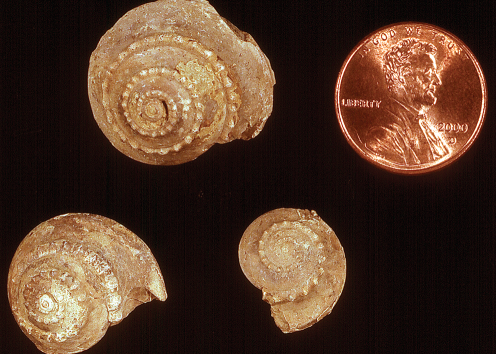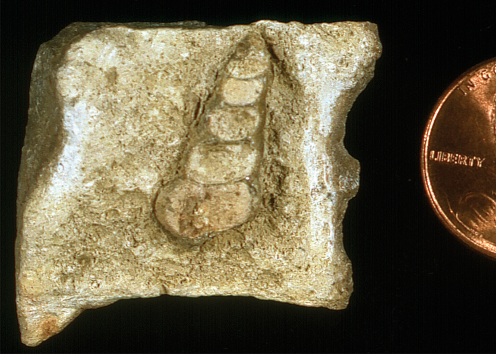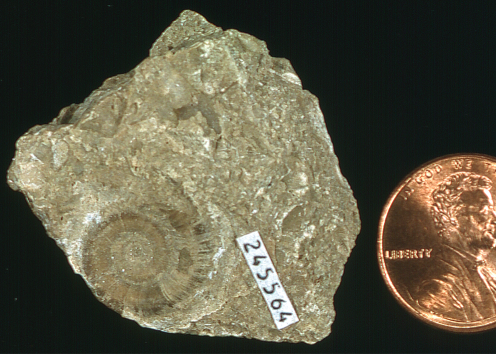Snails and Other Gastropods

Gastropods are the most diverse and abundant type of mollusks, with nearly 35,000 living and 15,000 fossil species identified so far. The group includes snails, slugs, conchs, whelks, and limpets. Like the familiar snail, most gastropods have a single coiled shell (slugs being a notable exception). A variety of fossil gastropods occur in the Pennsylvanian and Permian rocks of eastern Kansas.
The earliest undisputed gastropods date from the Late Cambrian Period, around 500 million years ago. Some paleontologists think gastropods are even older, based on a small, shelly fossil called Aldanella, known from Lower Cambrian rocks, but others think Aldanella is a worm. Either way, by the end of the Cambrian, gastropods were abundant and diverse, and they continue to be so up to the present day.
In a typical shelled gastropod, such as the snail, the soft body parts include those that normally extend outside the shell—the head and foot—and those that remain inside—the mantle and visceral mass. Because the fossil record of gastropods is based almost exclusively on the shells, paleontologists rely on living gastropods for information about the anatomy of their ancient relatives.
The shells of different gastropods vary enormously, and these variations are used to distinguish one species from another. Most gastropod shells are coiled. This coiling may be in one plane, similar to the shells of coiled ammonoids. Other gastropod shells may be coiled in such a way as to produce spires of varying heights. The outer surface of the shells may be ornamented with ridges, grooves, bumps, spines, or other markings.
The earliest gastropods were exclusively marine, but by the Mesozoic Era, about 252 million years ago, many had adapted to terrestrial and freshwater environments. During their long history, gastropods have developed many different ways of obtaining food. Some are carnivores, while others are herbivores, omnivores, deposit feeders, scavengers, suspension feeders, and parasites. Some carnivorous gastropods use their radula to rasp through the shells of other gastropods or bivalves, drilling a neat, round hole, through which they inject a muscle relaxant. Fossil shells with drill holes are evidence of gastropod predation, probably dating back to the Devonian Period (419 to 359 million years ago).
The long fossil record and present-day abundance and diversity of gastropods attests to their evolutionary success. Over time, they have withstood a number of major extinction events that wiped out other creatures.
In Kansas, fossils of marine snails are common in the Pennsylvanian and Permian rocks of the eastern part of the state and in the Cretaceous rocks farther west. Fossils of terrestrial and freshwater snails are also common in some Pleistocene deposits in northwestern and northeastern Kansas.
Stratigraphic Range: Upper Cambrian to Holocene.
Taxonomic Classification: Gastropods belong to the kingdom Animalia, phylum Mollusca, class Gastropoda.
Text and photos from Windows to the Past: A Guidebook to Common Invertebrate Fossils of Kansas, Kansas Geological Survey Educational Series 16.
Sources
Boardman, R. S., Cheetham, A. H., and Rowell, A. J., 1987, Fossil Invertebrates: Boston, Blackwell Scientific Publications, 713 p.
Clarkson, E. N. K., 1979, Invertebrate Palaeontology and Evolution, 3rd Edition: London, Chapman and Hall, 434 p.
Levin, H. L., 1999, Ancient Invertebrates and Their Living Relatives: Upper Saddle River, New Jersey, Prentice Hall, 358 p.
Moore, R. C., Lalicker, C. G., and Fischer, A. G., 1952, Invertebrate Fossils: New York, McGraw-Hill Book Co., 766 p.
Moore, R. C., ed., 1960, Mollusca 1, Part I; in, Treatise on Invertebrate Paleontology: Boulder, Colorado, and Lawrence, Kansas, Geological Society of America and The University of Kansas, 351 p.



